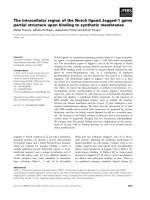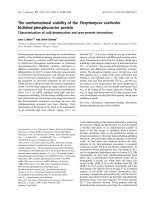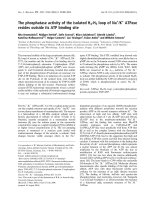Báo cáo khoa học: The structural basis of calpain behavior pptx
Bạn đang xem bản rút gọn của tài liệu. Xem và tải ngay bản đầy đủ của tài liệu tại đây (141.45 KB, 2 trang )
MINIREVIEW SERIES
The structural basis of calpain behavior
Yves Benyamin
UMR5539, EPHE-CNRS-UM2, cc107, Universite
´
de Montpellier II, France
Calpains are intracellular Ca
2+
-regulated cysteine pro-
teases which mediate regulatory cleavage of specific
substrates. They cover a broad range of physiological
functions including proteolysis of molecules involved
in cytoskeletal organization, the cell cycle, signal trans-
duction, apoptosis, and protein renewal during growth
and tissue regeneration. Originally found in mamma-
lian skeletal muscle then in numerous organisms inclu-
ding protists and plants, their expression is ubiquitous
[1,2].
Among the 14 members of the calpain gene family
with different expression patterns in tissue develop-
ment, two ubiquitous isoforms, microcalpain (l-cal-
pain or calpain 1) and milli-calpain (m-calpain or
calpain 2), have been the focus of three decades of
intensive characterization. In vitro analysis has shown
that the Ca
2+
concentration required for optimal
activity is 5–50 lm for calpain 1 and 0.2–1 mm for cal-
pain 2. A large range of substrates and a common
inhibitor (calpastatin), also found in the nucleus, were
identified. Knowledge of the 3D structure of Ca
2+
-free
calpain 2 and a chimeric l,m-calpain has provided
mechanistic concepts for understanding their allosteric
regulation [3–6].
Briefly (Fig. 1), ubiquitous calpains have an 80-kDa
catalytic subunit (backbone representation) and a
28-kDa regulatory subunit (space-filled representation),
which functions as a chaperone to stabilize the 80-kDa
structure. The critical importance of the 28-kDa sub-
unit, which is common to the two calpains, was shown
by the fact that transgenic mice with a knock-out gene
die at an early stage of embryonic development. This
subunit contains a mobile hydrophobic segment
(dashed purple segment) and a penta EF-hand domain
(DV and DVI, respectively). In the 80-kDa subunit,
the N-terminal segment (DI) interacts with DVI which
anchors DII (catalytic domain) to the 28-kDa subunit.
DII (DIIa and DIIb) interacts strongly with DIII via
electrostatic bonds (+ ⁄ –). Each DII subdomain
includes a part of the catalytic triad (red stars). This
Ca
2+
-free configuration corresponds to a structurally
inactive conformation of calpain 2. DIII is related to
the spatial organization of the C2 domain and binds
Ca
2+
ions and phospholipids. DIV, structurally similar
to DVI, also contains five sets of EF-hand motifs.
Note that the fifth set of EF-hand motifs of each
domain are unable to bind calcium and serve to bridge
the two subunits (crossed yellow squares).
Upon Ca
2+
binding (yellow squares), salt bridges
that keep the catalytic domain (DII) in an open con-
formation are disrupted (transducer signals) and the
Fig. 1. Calpain 2 (accession number: 1DFO) representation using
the Cn3D software from NCBI. The probable position of DV [4] is
added to the picture. The different calpain domains of the catalytic
subunit circled in black (DI), pink (DIIa), blue (DIIb), brown (DIII),
green (DIV) are indicated. Other details are in the text.
doi: 10.1111/j.1742-4658.2006.05353.x
FEBS Journal 273 (2006) 3413–3414 ª 2006 The Author Journal compilation ª 2006 FEBS 3413
two parts, DIIa and DIIb, come closer together, with
concomitant release of constraints between the
domains (large arrows). This active conformation of
DII successively initiates proteolysis activity, intermo-
lecular cleavage in DI then DV with possible subunit
dissociation, substrate proteolysis, and, finally, loss of
calpain activity upon increased autolysis of the 80-kDa
subunit, all in a few minutes. At physiological [Ca
2+
],
calpastatin blocks calpains via several contacts (blue
squares), which tie up the mobile structure to form a
long-lived complex.
Several questions are raised by these molecular stud-
ies. What is the correlation between the in vitro and
in vivo Ca
2+
requirements for calpain activity? How
do the two isoforms target their specific substrates
in vivo? Can we obtain a clearer picture of calpain
mobility between calpastatin complexes and proteolysis
sites, including the translocation to membrane phos-
pholipids and the nucleus? We also need to identify
the cell’s safeguards which prevent inappropriate clea-
vage during transient increases and oscillations of
[Ca
2+
], in particular those involving specific phos-
phorylations of calpastatin, calpains and targets.
The following Minireviews develop three themes on
the role of calpain 1 and 2 in cytoskeletal anchorage
and sarcomere stability, on the specific behaviour of
calpain 3 (p94) in muscle cells and on apoptosis mech-
anisms in neuritic cells.
References
1 Goll DE, Thompson VF, Li H, Wei W & Cong J (2003)
The calpain system. Physiol Rev 83, 731–801.
2 Zatz M & Starling A (2005) Calpains and disease.
N Engl J Med 352, 2413–2423.
3 Hosfield CM, Elce JS, Davies PL & Jia Z (1999) Crystal
structure of calpain reveals the structural basis for Ca
2+
-
dependent protease activity and a novel mode of enzyme
activation. EMBO J 18, 6880–6889.
4 Strobl S, Fernandez-Catalan C, Braun M, Huber R,
Masumoto H, Nakagawa K, Irie A, Sorimachi H, Bou-
renkow G, Bartunik H, et al. (2000) The crystal structure
of calcium-free human m-calpain suggests an electrostatic
switch mechanism for activation by calcium. Proc Natl
Acad Sci USA 97, 588–592.
5 Pal GP, De Veyra T, Elce JS & Jia Z (2003) Crystal
structure of a micro-like calpain reveals a partially acti-
vated conformation with low Ca
2+
requirement. Struc-
ture (Camb) 11, 1521–1526.
6 Bozoky Z, Alexa A, Tompa P & Friedrich P (2005)
Multiple interactions of the ‘transducer’ govern its
function in calpain activation by Ca
2+
. Biochem J 388,
741–744.
Yves Benyamin is currently Professor of Cellular Biochemistry at the Ecole Pratique des Hautes Etudes in Paris.
His doctoral work on the evolution of muscle kinases was conducted at the Colle
`
ge de France in Paris. In 1977
he joined the National Center of Scientific Research (CNRS) in Montpellier where he started his group on cyto-
skeleton protein interactions. Since 1997 he has been studying the role of calpains in cell behavior at the Uni-
versity of Montpellier.
The structural basis of calpain behavior Y. Benyamin
3414 FEBS Journal 273 (2006) 3413–3414 ª 2006 The Author Journal compilation ª 2006 FEBS









